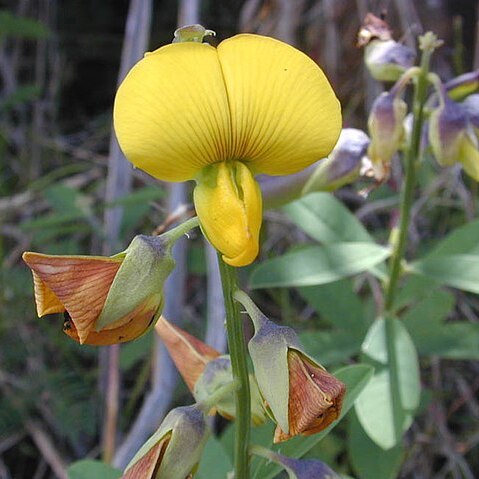Large shrub to small tree 3-5(10) m tall, reseeder, colonial. Stems erect, 1(2), rigid, diameter up to 50 cm, green with vertical grey stripes and irregular lenticels when young becoming grey when old with scattered irregularly storied white lenticels, branching from near base when young, shedding branches when older. Seasonal shoots green, villoso-pubescent. Leaves 7-9(11)-foliolate, spreading, glabrescent above, wispily hairy below, petiolate; leaflets 30-50 x 1-2 mm, terminal leaflet shortest, basal pair longest, decreasing in length towards the apex, uppermost three leaflets digitately inserted, linear or linear lanceolate, terete to flattish, acute, base rounded, glandular, adaxial surface grooved, abaxial surface convex, vein on adaxial surface prominent; green, cavities slightly sunken in fresh state, petioles 5-8 mm long, shorter on younger leaves; rachis 10-12 mm long; stipules 2-3 x 12 mm, persistent, shorter than petiole, fused for part of their length, margins inrolled, ovate, hairy, rapidly senescent, callous, recurved. Inflorescences axillary, well exerted from leaves, borne in upper axils of seasonal shoots without leafy extension, 1-3-flowered per axil, pseudo-capitate, congested or laxly clustered in axils, pedunculate, pedicellate; peduncles stout and rigid, 45-60 mm long, longer than the subtending leaf, hairy; cupulum, bilobed, minutely hairy at the margins of equally developed lobes, covering base of calyx, broadly triangular, senescent becoming yellowish and papery, glands green turning orange with age; pedicels 2-4 mm long, black-haired. Flowers (10)13-15(19) mm long, very broadly ovate, deep blue to purple. Calyx 6-8 mm long, tube 4-5 x 4.5 mm, densely hairy, mainly black-haired with or without occasional white hairs; lobes equally developed, shorter than the tube, blackish, lateral and vexillar large, reflexed, emarginate, acuminate, fused for about one third their length, carinal same width as other four, small, incurved. Standard petal 15-16 x (13.5)14.5-15 mm, very broadly ovate, swollen but not ridged at apex, auricles slightly swollen, deep mauve to purple with large M-shaped white nectar guide with a dark purple flash in crotch, paler towards margins, veins darker than blade; claw 4-6 mm long, deeply channelled. Wing petals 14 x 5 mm, widest at two-thirds its length, mauve, blade folded and puckered along its mid-line, sculpturing present, basal, comprised of 2-3 rows of 10-14 transcostal lamellae; claw 4 mm long. Keel 10-11 x 3.5-4 mm, blade ridged for 3 mm from base, white; apex purple on inner face; claw 5 mm long. Androecium 12 mm long, tenth stamen lightly attached, fenestrate. Pistil 12 mm long, ovary 3 mm long, style 6 mm long, upper end covered in club-shaped glands, height of curvature 4 mm, widest at point of flexure, stigma penicillate. Fruits 4-5 x 3 mm, oblong. Seeds 4.5 x 2.8 mm.
More
Peduncles 15–25 mm long, 1-flowered, fasciculate, 1–3(6) together, axillary in upper leaves and terminal, pubescent with black hairs; 2 bracts at the apex united to form a cup around the peduncle, c. 3 mm long, split on one side, at first close to calyx base but later distant when the true pedicel elongates, bristly pubescent with black hairs.
Leaves 5–7(9)-foliolate; leaflets 10–50 × 1.5–4(6) mm, linear-oblong to linear-lanceolate, apiculate at the apex, cuneate to narrowly rounded at the base, densely gland-dotted, glabrous to sparsely pubescent; stipules separate, thickened, 2.5–4 × 2 mm, ovate-lanceolate, acuminate.
Standard dark violet or blue, paler at the margins, 13–15 × 12–15 mm, broadly obovate with white claw 4 mm long; wings white below and pale violet in the upper half, 12.5–13 × 4–6 mm with claw 7 mm long; keel about as long, white, apically suffused with dark violet-purple.
Calyx tube 6 mm long, lobes 4–5 × 3 mm, oblong-ovate, subequal, subacute or rounded at the apex, the lowest the largest, both tube and lobes glabrous to pubescent on the outer surface (and lobes within) with characteristic black hairs; margins of lobes ciliate.
Fruit 6 × 3.8 mm, ellipsoid, wrinkled; seed dark brown, 4.2 × 3 mm, ellipsoid; hilum 1.2 mm long.
Ovary c. 3 mm long with stipe 1 mm long; style straight for c. 7 mm then curved upwards for 4 mm.
Tall, reseeding shrubs to 5 m. Leaves 5-7-foliolate. Flowers mauve and blue.
Woody shrub or subshrub 1–3.5 m tall; branches striate, hairy or glabrous.
Vexillary filament shortly united with staminal sheath at the base.

